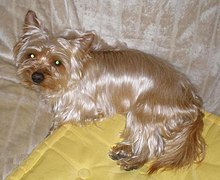hide

The skin of mammals with a hair density of 50 to 400 hairs per square centimeter is referred to as fur (from Middle High German “fel / vël”, originally from humans and animals, whether hairy or hairless) (according to the definition by Dathe / Schöps) . With less hair density it is considered hairless skin, with thicker hair the skin is referred to as fur (according to a definition, more than 400 hairs per square centimeter). The coat is made up of the outer hair (upper hair) and the woolen hair (undercoat). The fur serves to protect the skin and store heat. Many mammals actively adapt their hair to the weather conditions by changing their coat seasonally ( evolutionary adaptation ). The color of the fur is often used as a camouflage, and in some animal species as a warning signal. The change of coat can also be accompanied by a change in coat color, as with the ermine with its white winter coat as a camouflage color in the snow. For many people, the fur of mammals has an emotional meaning. Various small animals such as dwarf rabbits , guinea pigs etc. are kept as petting animals. In order to meet the need, especially among children, to stroke animals and to enter into a relationship with them through tactile communication , there are petting zoos that have been set up especially for this purpose .
Animal skins have been used to keep people warm since the Ice Age . In historical times, the visual effect of fur and fur clothing came into play, which is also of emotional importance for people who no longer have thick hair, but still have a tendency to touch or look at them.
In the leather trade, the skins of some young animal species are called fur ( kidskins , lambskins ). The peeled off fur is generally referred to as fur, in the fur industry one speaks collectively of tobacco goods, Austrian rough goods. In the hunter's language , the fur of some animal species is given different names, e.g. B. as rind in wild and roof or ceiling when deer . The carcass side is the inner side, i.e. the meat side of the raw hide or skin. In the case of the tanned (technically “trimmed”) fur, it is then the leather side.
For the different types of fur, see main article → Types of fur . Since bird skins are almost no longer used for clothing and other items, the name bellows is almost the only common name.
Fur has long been a major problem for computer graphics , largely because of its geometric and optical complexity. Among other things, algorithms had to be found that optimized the mutual shading of each individual hair and made such images predictable in a realistic time . The first feature film to exploit this technology was Pixar's 3D animation Die Monster AG from 2001.
See also
- Knee skin (leather garment for drummers in the Prussian army)
Web links
Individual evidence
- ^ Heinrich Dathe , Paul Schöps et al.: Pelztieratlas. Gustav Fischer Verlag, Jena 1986, p. 17.
- ^ Hans Geyer: hair. In: Franz-Viktor Salomon, Hans Geyer, Uwe Gille (Ed.): Anatomy for veterinary medicine . 2nd ext. Edition. Enke-Verlag, Stuttgart 2008, ISBN 978-3-8304-1075-1 , pp. 637-640.

